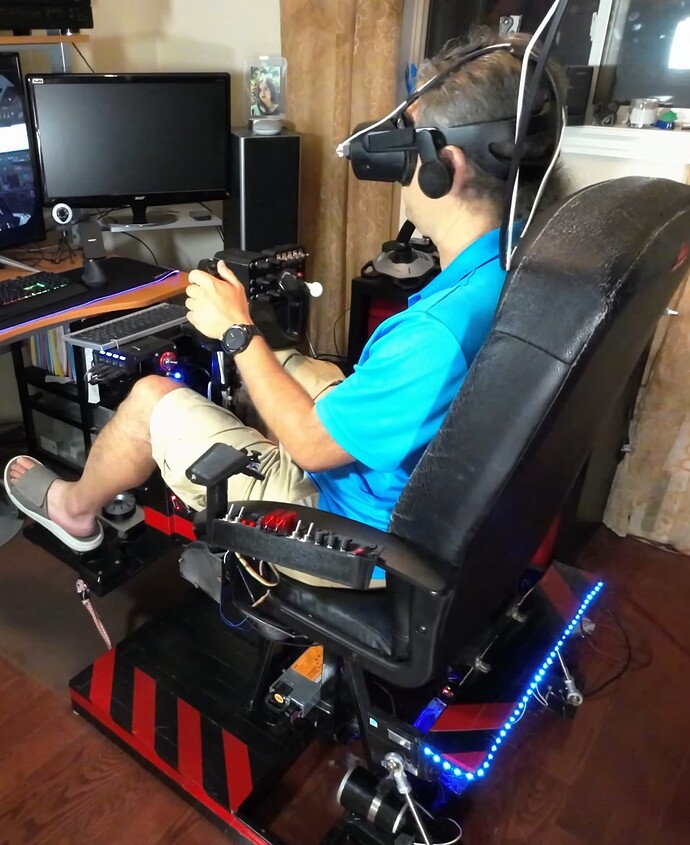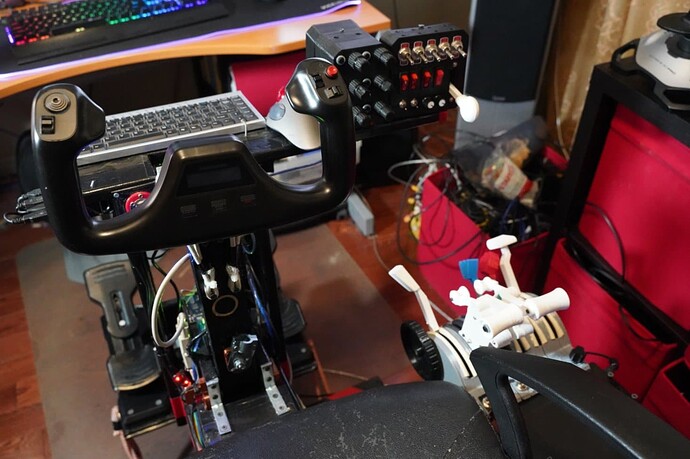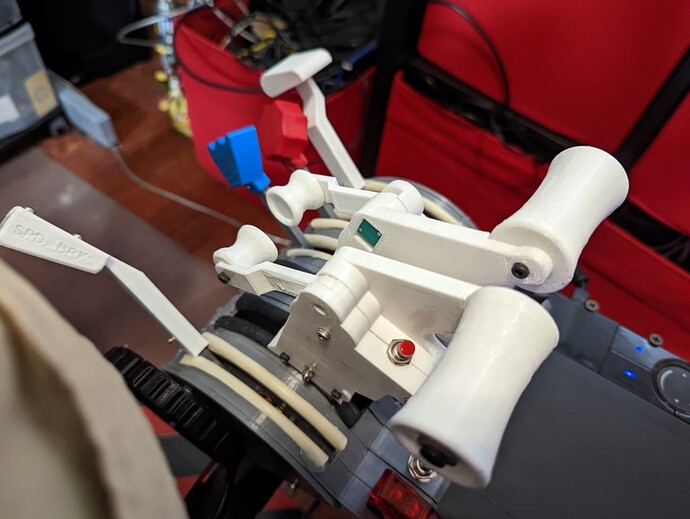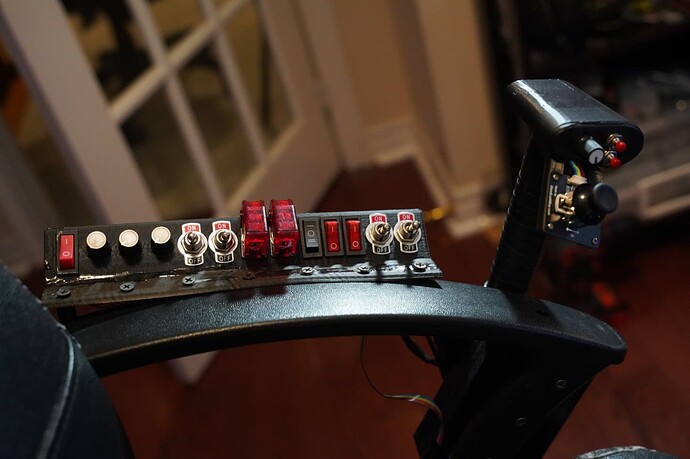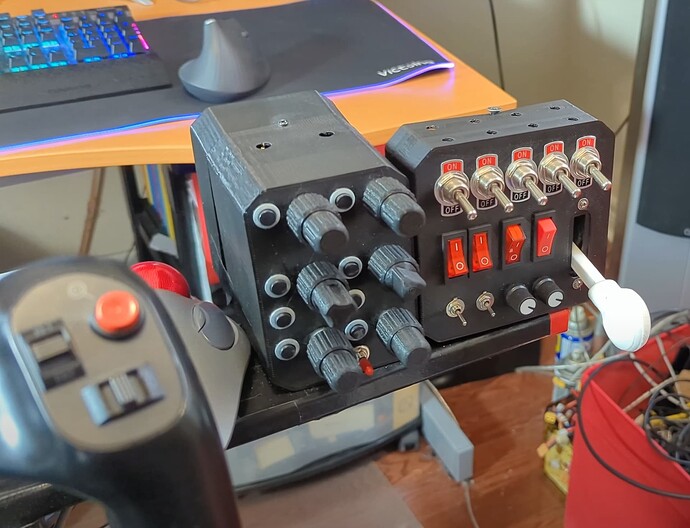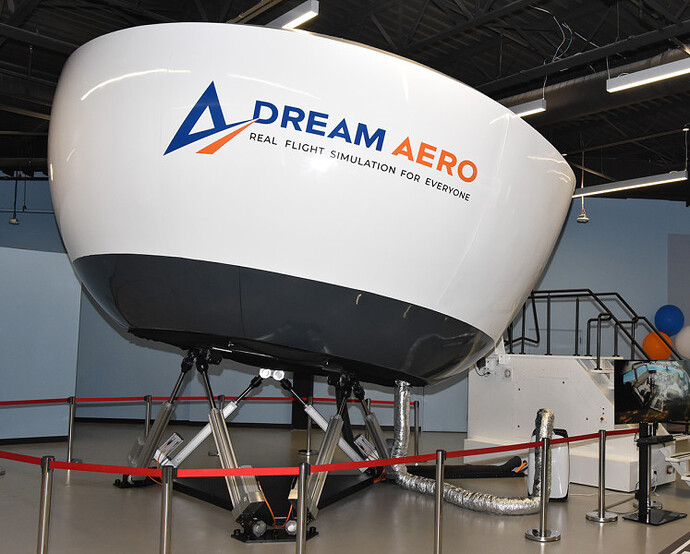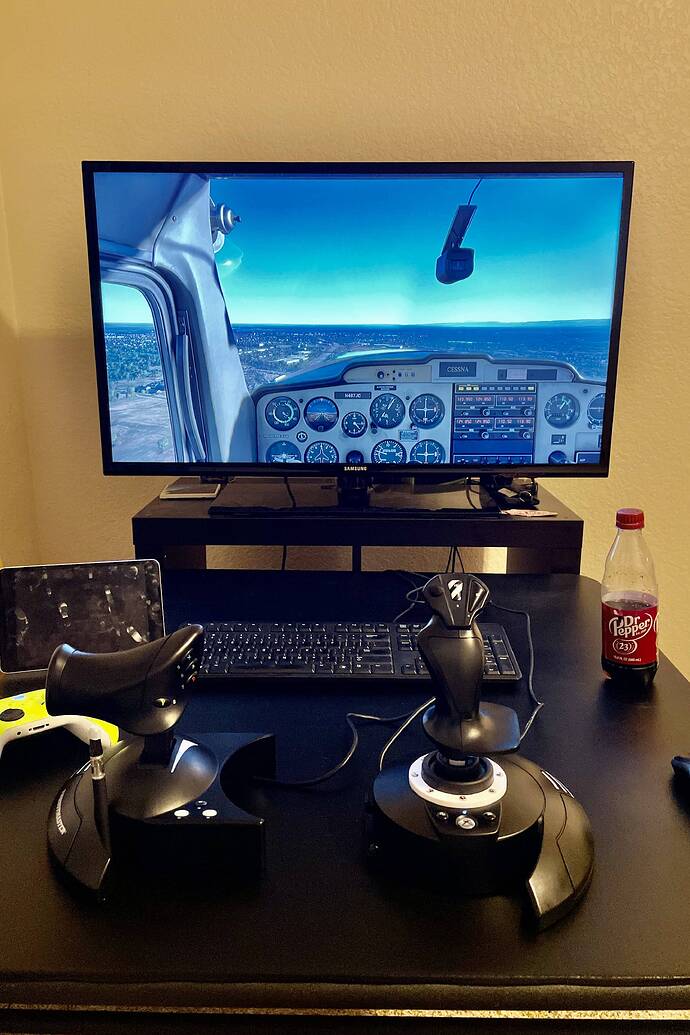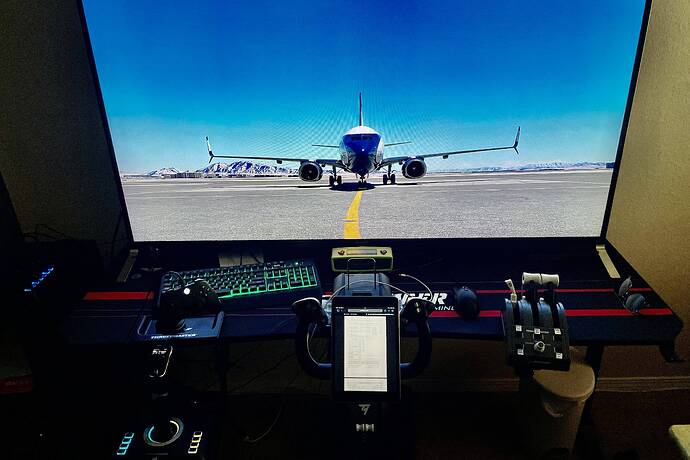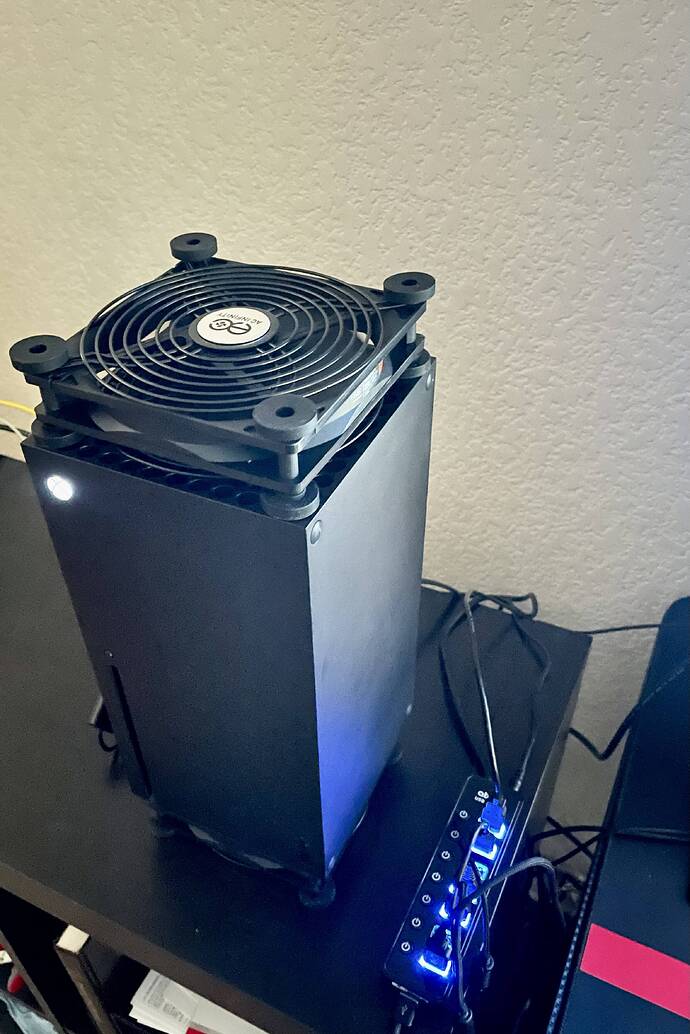Motion Simulator
Side View
Pendular Yoke, Throttle Quadrant with trim wheel and reversers, Dual Encoder box, Switchbox with Gear lever
Cockpit in action
Throttle Quadrant - Boeing 737 inspired + Prop controls
HOTAS convertible to heli Collective + Switchbox + Thumbstick
6 Dual Encoder box + Switchbox with Gear lever
Joystick + HOTAS configuration
Heli Cyclic + Collective configuration
Very nicely done. How much time do you have invested in this project? I assume a lot…
Yes, it took quite a while, but was done in stages. Overall, not as much time as you’d think. I was willing to invest time, but money was the limiting factor. The whole budget was less than $500! The goal of my project was to build a cheaper and better alternative to off-the-shelf motion rig and controls. I wanted something that is not just much much cheaper (because I couldn’t and wouldn’t want to afford at lest $4500 to buy the equivalent but worse system), but also modular and easily convertible to yoke+throttle / joystick+hotas / cyclic+collective configurations and to any aircraft I’d feel like flying.
It started as a way to save money and being able to afford a real motion rig, but ended up being IMHO better than anything that can be bought off-the-shelf for my particulate use case.
So I designed the motion rig that has exactly what I need, and the controls that are built for VR: Instead of modeling a specific cockpit, they are very compact, and have different encoder and switch shapes for easy tactile feedback. By feel I know exactly where my hand is at any time, around the encoder box and switch box. The throttles are 737-inspired and have the authentic design and feel, including analog reverser lever axes, TO/GA and T/A disconnect buttons etc. but hey also have prop and mix levers which can be selectively operated left/right engine by holding a yoke hat switch left or right.
Dual encoder box controls the entire functionality of GNS550, and also most 737 autopilot panel knobs and buttons, and analog instrumentation like heading bug, nav/com radios etc. Other systems like G1000 have partial control for obvious reasons (touchscreens and sideline nav buttons). In any case, I have most controls at my fingertips at all times, so almost the entire flight can be done without using VR controllers or mouse. GA planes have everything covered by my switchboxed from cold and dark state. Airliners would need controller/mouse interaction during FMC setup and some of the engine start-up, but after that, almost everything is also covered by my cockpit.
The main thread with videos and more details is here, and all design files and part lists are available on my website.
Wow, that’s impressive to get a motion rig for $500, even if it’s basic and DIY…
well done.
Are you using motion cancelling software to subtract the seat movement from the VR view? If so, how well does it work?
It doesn’t feel basic ![]() All the motion I could wish for and vibration totally fools my brain in VR. And DIY is a pro, not a con: I don’t believe any off-the-self solution like this even exists - I’m talking about converting the controls in a couple of minutes to yoke/throttles to joystick/hotas to cyclic/collective, at least not with the large-throw sticks and pendular yokes.
All the motion I could wish for and vibration totally fools my brain in VR. And DIY is a pro, not a con: I don’t believe any off-the-self solution like this even exists - I’m talking about converting the controls in a couple of minutes to yoke/throttles to joystick/hotas to cyclic/collective, at least not with the large-throw sticks and pendular yokes.
Yes, I use OXRMC that gets the motion rig position data from FlyPT Mover’s OVRMC “virtual tracker” module. It works perfectly. No need for extra trackers or hardware. It was tricky to set up, but once I got the numbers right it works fine. But with limited movement (and you don’t need a lot for VR, just motion cues) it’s not bad even without motion compensation. Though it’s better with it of course.
basic compared to the 6DOF $20k rigs ![]() but better than most $5k seats.
but better than most $5k seats.
@StarThe2nd1589
Seriously now, what do you expect?
I think @RomanDesign did an outstanding job even compared to the $$$$, (££££, €€€€, etc), rigs, especially since it can be reconfigured in so many ways, for so many different types of aircraft, and without needing significant amounts of effort.
Even the fancy full-motion rigs like the Dream Aero cockpit shown above are limited to one single aircraft type/family.
I have seen commercial rigs, (for X-Plane), that have a very limited ability to be re-configured, (usually within a limited range, such as single engine/dual engine or standard instruments/glass cockpit). And! They have prices that are nearly the cost of the aircraft themselves, and they DO NOT INCLUDE VR!
If this were an off-the-shelf commercial rig, it would easily exceed the $20k benchmark you established, and likely exceed the cost of comparable existing commercial training rigs[1]. The fact that he accomplished this for such a low price takes this all the way from “jaw-dropping” to “HOLY CHRISTMAS BATMAN!!” [eyeballs bugging out]
Without qualification, (IMHO), his vision and execution is second to none. What he did is both outstanding and unprecedented in this user space, and I salute him.
![]()
![]()
![]()
[1] Based on the limited research I have done, there are no comparable rigs available for the consumer market, and darn few, (if any!), for the relevant commercial market too.
I mean you can’t deny a DIY dream aero would look absolutely sick ![]()
![]()
But yes he did a great job all round and impressive for the budget as-well.
THAT’S a cockpit I would pay to see.
I agree, it would be both totally bent and totally righteous!
Actually, if you had four Arduinos, some BUTT KICKING power drivers for the pump motors, four hydraulic cylinders kicking around, (and a barn with nothing better to do), you could conceivably do it on the cheap.
P.S.
You might want to include a Jetson Nano as the interface controller, and you will need to dedicate a significant amount of your life to the software design.
People actually build 6DOF rigs, it’s not that much harder to build than what I did, but there are a few caveats:
- The cost skyrockets fast. 2DOF motors only have to push you and the seat around on a u-joint, which bears most of the weight, but 6DOF has to bear and lift your entire weight. So it’s not just the mechanically complicated and expensive linear actuators, but also much more powerful motors that are required, and 6 of them instead of 2. And those are very expensive. Add up all the aluminum and steel for the frame and moving parts - I just used wood, which is cheap or free if you have some scraps lying around.
- VR makes a huge difference in what is required of the motion rig. It’s not just the fact that it doesn’t have to move triple-monitor assemblies, but the real motion and perceived motion in VR don’t need to be the same magnitude. All you need are motion cues to trick your brain into thinking you’re moving a certain way, and as a result, small motions of the rig translate to large and wide motions you are actually feeling. So I often tone down even the modest movement my rig has (there’s a pot for that), because it can feel too violent in flight.
- Your head and your vestibular system are not at the COG! The COG is the U-joint just under the seat. Your head is above and behind the center of rotation. That makes it possible to mix in Surge (forward-backward acceleration forces) and Heave (up-down motion) into the pitch axis but limit it to end before it’s perceived as a pitch rotation. Similarly, Sway (yaw motion) is mixed in to roll in a similar manner. So it really feels like it’s more of a 6DOF despite it being only a 2DOF. So much so I scrapped my plans to add another motor for “traction loss” or “yaw” if the 2DOF worked well. I just feel there’s no need. The rig is so immersive, especially together with the vibration, that the illusion is almost total, as much as VR allows.
- Space. My rig is compact and takes barely more room than a large office chair. But even a “compact” 6DOF is so large it almost needs its own room or it takes a large chunk of a basement entertainment “cave”.
The important part is this: in my opinion, a 3DOF or 6DOF rig is better, of course, but the perceived hypothetical 10% better VR immersion difference is just not worth the effort and cost and dedicated space involved. But to each his own - some people are willing to sink many thousands for that last 10% or even 1% - it’s like audiophiles. You can have a junk home theatre audio system for a few hundred, of a decent one for a few hundred more, or an amazing sounding system for $2 to 5k (my case). And then you can sink $15k and above easily, and there is no upper end, some people spend crazy money to just get that 10% or 1% better. It’s the game of diminishing returns. You get to find your sweet spot.
Yes indeed it makes it much more complex. With your motors, how does your weight affect with the responsiveness of the motors? I saw some motors on ali express high torque similar to the ones on ebay will a stall torque of 100kg, but I assume they slow down considerably before stalling and I assume with just a motor or two per axis you’d be close to the stall torque with the seat and setup considered?
My motors are not from Ali, parts lists are on my websites. I got motors from Ebay, they are used for sawmills or something like that. I don’t feel any slowdown at all. they have so much torque that in an emergency landing or a crash they almost throw me out of my seat… Very snappy.
Yes I was aware you didn’t get your motors from ali express, how-ever the datasheet seems kinda vague and doesn’t show a stall torque in kg so was wondering how they felt. $200nzd is slightly out of my price range for motors if I went with motors so trying to find a china alternative that operates well up until stall.
A good alternative is a windshield wiper motors from a large truck, you can find them on a local scrap yard and they often come in pairs. I just don’t have a scrapyard close, so bought the specific eBay ones that were recommended. Not much specs exist for them though.
I like you low cost approach. I scavenged my motors from electric wheelchairs I found at the landfill. My u-joint is a truck steering shaft that came from the junkyard. I’m using three motors with a spring (same junkyard) around the steering shaft to allow for heave motion. I may also be able to use the wheelchair motor driver boards as well. Now all I need is the time to finish it.
Please folks, keep this post only for photos. You have an entirely subforum for discussing your projects.
Sure thing, i was only answering direct questions. Anyone wants to ask more or comment - please use the dedicated thread for my motion VR rig
This was my setup when the sim came out on Xbox. 32inch TV, Series S, Hotas One, Xbox Controller and a wobbly card table.
Currently using this setup, 65inch, Series X, TM Boeing setup and Tflight rudders, TB Stick on a TM clamp, on a 63 inch desk. NLR HF8 on an old office chair. iPad mounted to the yoke using a magnet phone base, same for the Xbox controller. Still a long way to go for me but gets the job done.
Next up is a NLR Boeing simpit later this month. Honeycomb Alpha and Bravo to come probably in July along with some new pedals.
Series X has two 140mm fans(top and bottom) and a powered USB hub to handle the sim and peripherals.
Do you have model #, source, etc., for your cooling fans?
